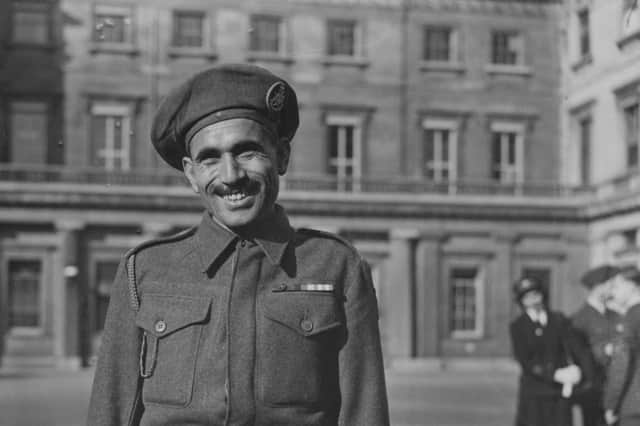World War history: Scottish schools should teach pupils about British Indian Army's contribution to both conflicts – Saqib Razzaq


The youngsters, aged 12 to 22, laid wreaths and took part in a multi-faith remembrance service for south Asian soldiers and to thank local resident Isobel Harling who has tended to their graves for more than 70 years. They were at Kingussie New Cemetery in the Highlands, where nine Force K6 soldiers are buried.
Those soldiers were among the hundreds of thousands who answered the urgent call made to the Indian empire – then the joint Indian and Pakistan subcontinent – during the Second World War to come to Europe to help the British forces. Force K6, mainly the Muslim Mule Transport Corps of the Royal Indian Army Service Corps, arrived in Marseilles in December 1939.
Advertisement
Hide AdAdvertisement
Hide AdThe bulk of Force K6 was then evacuated out of Dunkirk in France to Britain, and while training in Scotland some died in the cold mountainous regions of the Highlands. This story, and the immense contribution of south Asian soldiers to Britain’s war efforts, is still not widely known.
At Colourful Heritage, we have been working with politicians, schools, and community groups to enable more people to learn about the sacrifices that were made and to reflect on the commonality of our humanity. We help to organise annual remembrance services at Kingussie, while in Glasgow we are campaigning for a permanent memorial to all multi-faith south Asian soldiers, which would be a lasting reminder of the service and sacrifice of the British Indian Army (BIA).
The BIA contributed an extraordinary 1.5 million servicemen in the First World War and 2.5 million in the Second World War. More than 160,000 members died, and hundreds of thousands were injured.
A planning application has been submitted to Glasgow City Council to ensure these forgotten soldiers finally have a permanent memorial to their sacrifice, and we hope it is swiftly given the go-ahead. When it is built, the memorial will show people in Scotland from different ethnicities that they can be proud of their role in our country’s shared history which can further their sense of belonging.
But remembrance services and memorials are not enough. And why does it take a charity to show the leadership on this? More than a year-and-a-half has passed since the then Prime Minister Boris Johnson apologised on behalf of the UK Government for failures to properly commemorate black and Asian service personnel who died fighting for Britain.
An investigation by the Commonwealth War Graves Commission confirmed that “pervasive racism” meant that thousands of First World War casualties “were not commemorated by name or possibly not commemorated at all”. But what has changed since that landmark apology? This should have been a watershed moment for our institutions – yet once again the hard work in recent months has fallen to charities.
We are surprised the British Army hasn’t taken more of a proactive role, and we urge Glasgow City Council to promptly approve the memorial application submitted in March 2022. There is an opportunity for Scotland and its institutions to lead the way. And the most obvious place where lasting change can be achieved is in our schools.
Colourful Heritage has created a digital school resource pack to highlight the contribution of the south Asian community to Glasgow and Scotland. It consists of five units specially designed for Primary 6 and 7, high school pupils, and all teachers in training and comes complete with case studies, suggested lesson plans, a list of experiences and outcomes, discussion points and options for further reading about a less-well studied element of Scottish history.
Advertisement
Hide AdAdvertisement
Hide AdThe aim of the pack is to highlight a narrative which is largely forgotten in the history books taught in schools, as well as the contribution of Scotland’s south Asians to business and politics, and their migration story to Scotland. We are grateful to all the teachers who have seized the opportunity to teach this vital part of our nation’s story to a new generation.
But it shouldn’t come down to individual teachers – this needs to be an examinable part of our national syllabus. The Scottish Qualifications Authority (SQA) should act now.
The Commonwealth War Graves Commission report was devastating, exposing a failure to commemorate the heroes who died, which was "influenced by a scarcity of information, errors inherited from other organisations and the opinions of colonial administrators". Johnson’s apology reminds us all that “our shared duty is to honour and remember all those, wherever they lived and whatever their background, who laid down their lives for our freedoms at the moment of greatest peril”.
So this is a direct plea to the SQA – prove that we have learned from past mistakes. Prove that no child growing up in Scotland will leave school without learning about the sacrifices of the soldiers of all faiths and none who travelled halfway around the world to fight alongside British troops. Prove that every child of Asian heritage in Scotland today will learn about our shared history, so that they grow up with a greater sense of belonging and identity. Because, without action, efforts to tackle intolerance and hatred in Scottish society will fail.
We are not immune to racism here. Just look at the recent vile comments online after First Minister Nicola Sturgeon posted a photo of herself with pupils at St Albert’s Primary in Pollokshields.
Every child in Scotland should grow up feeling that they belong. By learning about the story of Asian and Muslim heritage in Scotland, we can build a greater sense of togetherness. And by learning about the sacrifices that were made, we can reflect on the commonality of our humanity.
Saqib Razzaq is a project officer at the charity Colourful Heritage. The Colourful Heritage resource pack for schools can be found at www.colourfulheritage.com.
Comments
Want to join the conversation? Please or to comment on this article.